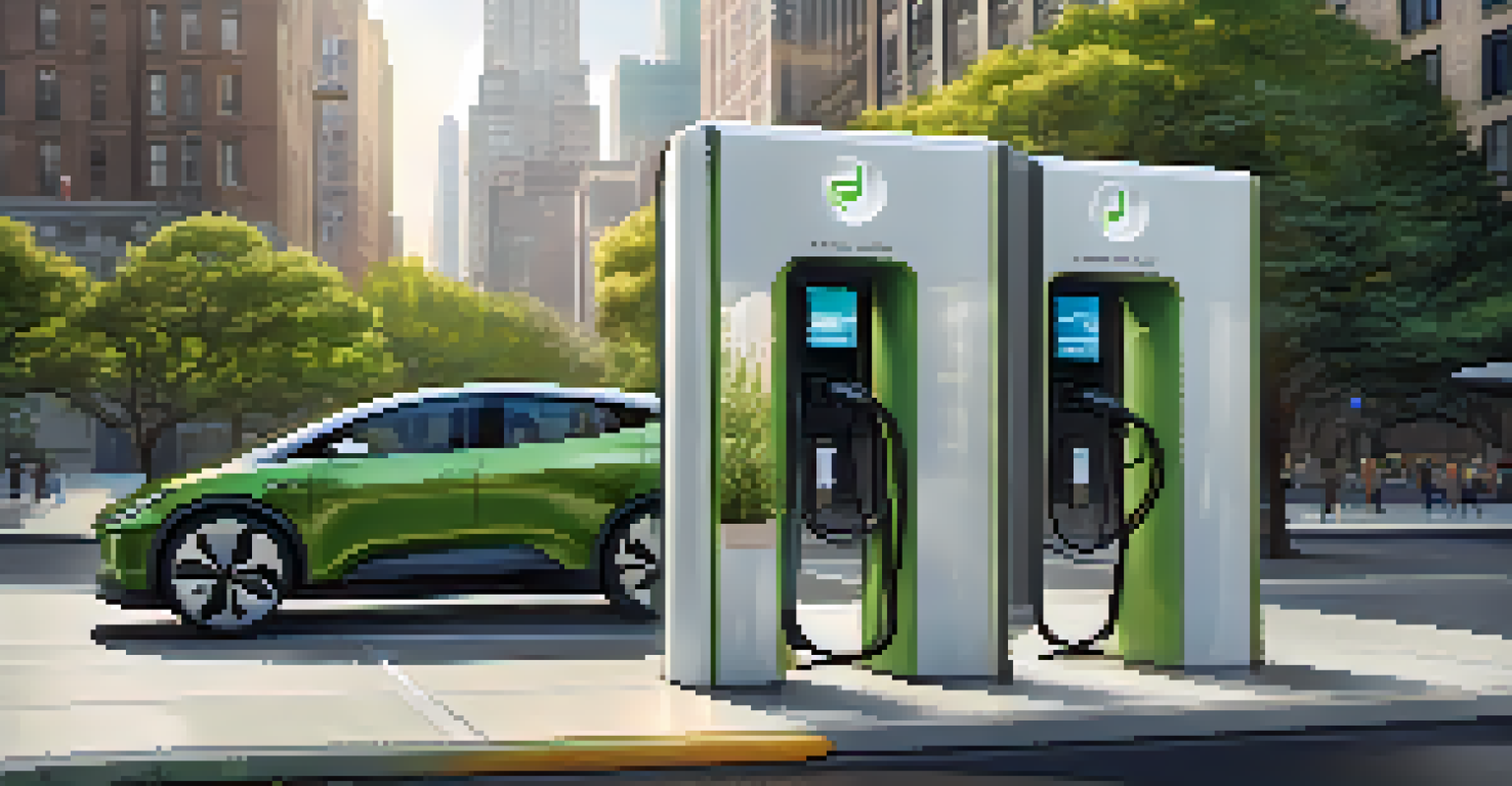The Impact of Electric Vehicles on NYC's Energy Future

Overview of Electric Vehicles in NYC
New York City is rapidly embracing electric vehicles (EVs) as part of its broader sustainability goals. With the increasing concern over air pollution and climate change, the city is positioning EVs as a cleaner alternative to traditional gas-powered vehicles. In recent years, the number of EVs on NYC roads has surged, marking a significant shift in transportation habits. This transition not only benefits the environment but also influences the city's energy consumption patterns.
The future will be green, or not at all.
The city has implemented various initiatives to encourage EV adoption, such as expanding charging infrastructure and offering incentives for EV purchases. As of now, there are thousands of public charging stations available, making it easier for residents to switch to electric. These developments reflect a growing recognition of the role that EVs play in reducing greenhouse gas emissions and promoting urban sustainability.
Moreover, the rise of electric vehicles in NYC signifies a cultural shift in how residents view personal transportation. Many New Yorkers are becoming increasingly aware of their carbon footprints and are eager to make eco-friendly choices. As EVs continue to gain traction, they are poised to redefine how the city navigates its energy challenges.
The Role of Renewable Energy Sources
As electric vehicles become more prevalent, the demand for renewable energy sources is also on the rise. NYC aims to power its EVs with clean energy, reducing the overall impact on the environment. The integration of solar, wind, and other renewable sources into the city's energy grid is crucial for achieving this goal. By harnessing clean energy, the city can ensure that EV charging contributes to a sustainable energy future.

In recent years, there have been significant investments in renewable energy projects across New York State. These initiatives not only promote energy independence but also create jobs in the green economy. As more renewable sources come online, they will complement the increasing electricity demand from EVs, creating a more resilient energy landscape.
NYC's EV Surge Enhances Sustainability
The increasing adoption of electric vehicles in New York City is contributing significantly to environmental sustainability and reducing greenhouse gas emissions.
Furthermore, the combination of EVs and renewable energy can lead to a more decentralized energy system. This shift allows for greater flexibility and efficiency in how energy is produced and consumed in the city. By tapping into local renewable resources, NYC can make strides toward a cleaner, more sustainable energy future.
Impact on New York City's Energy Grid
The growing number of electric vehicles in NYC presents both opportunities and challenges for the city's energy grid. As more residents switch to EVs, the demand for electricity is expected to rise significantly. This increased demand can strain the existing grid infrastructure, necessitating upgrades and enhancements to accommodate the influx of EV charging. Understanding how to manage this demand is crucial for ensuring a reliable energy supply.
Sustainability is no longer about doing less harm. It's about doing more good.
To address these challenges, NYC is exploring smart grid technologies that can optimize energy distribution. Smart grids use advanced communication and automation systems to monitor and manage electricity flow, making it easier to balance supply and demand. By integrating these technologies, the city can efficiently handle the increased load from EVs while minimizing the risk of outages or disruptions.
Additionally, the concept of vehicle-to-grid (V2G) technology is gaining traction, where EVs can return electricity to the grid during peak demand times. This innovative approach not only helps stabilize the grid but also provides EV owners with potential financial incentives. As NYC continues to integrate EVs into its energy landscape, these technologies will play a vital role in shaping the city's energy future.
Economic Benefits of Electric Vehicles
Electric vehicles are not just environmentally friendly; they also offer significant economic advantages for New Yorkers. The cost of operating an EV is generally lower than that of a traditional vehicle, primarily due to reduced fuel and maintenance costs. With gas prices fluctuating, many residents find that switching to an EV can lead to substantial savings over time. This economic benefit is particularly appealing in a city known for its high living costs.
Moreover, the shift to electric vehicles is creating job opportunities in various sectors, including manufacturing, installation of charging stations, and renewable energy production. As the demand for EVs increases, so does the need for skilled workers, contributing to local job growth. This shift not only supports the economy but also positions NYC as a leader in the green job market.
Renewable Energy is Key for EVs
Integrating renewable energy sources into NYC's power grid is essential for maximizing the environmental benefits of electric vehicles.
Additionally, government incentives and rebates for EV purchases further enhance the economic appeal of electric vehicles. These financial incentives make it more accessible for residents to invest in sustainable transportation options. By encouraging EV adoption, NYC can stimulate economic growth while advancing its environmental goals.
Challenges Facing EV Adoption in NYC
Despite the benefits, several challenges hinder the widespread adoption of electric vehicles in New York City. One of the primary concerns is the availability of charging infrastructure. While NYC has made strides in expanding charging stations, many residents still find it inconvenient to charge their vehicles, particularly those living in apartments or without dedicated parking. Addressing this issue is essential for encouraging more people to switch to EVs.
Another challenge is the perception of electric vehicles as being more expensive than traditional cars. Although operating costs are lower, the initial purchase price can be a barrier for many potential buyers. Educating consumers about the long-term savings and available incentives is crucial for overcoming this misconception and promoting EV adoption.
Lastly, there is a need for public awareness and education regarding the benefits of electric vehicles. Many residents may not fully understand how EVs work or the positive impact they can have on the environment. By fostering awareness and providing accurate information, NYC can help demystify electric vehicles and encourage more people to consider making the switch.
Government Initiatives Supporting EV Growth
The New York City government is actively supporting the growth of electric vehicles through various initiatives and policies. One of the key components of the city's sustainability plan is to transition its fleet to electric. This effort not only reduces emissions from city-owned vehicles but also sets an example for residents and businesses to follow. By leading by example, NYC aims to create a culture of sustainability and encourage more people to adopt EVs.
In addition to fleet electrification, the city has introduced several incentive programs to promote EV purchases. These initiatives include tax credits, rebates, and grants aimed at making EVs more accessible to a broader audience. By providing these financial incentives, the city is working to lower the barriers to entry and make electric vehicles a viable option for all residents.
Government Initiatives Boost EV Growth
New York City's government is actively promoting electric vehicle adoption through incentives, educational programs, and infrastructure expansion.
Furthermore, NYC is investing in expanding its charging infrastructure to support the growing number of EVs on the road. The city has partnered with private companies to install more charging stations in convenient locations, making it easier for residents to charge their vehicles. These efforts demonstrate the city's commitment to fostering a supportive environment for electric vehicles and promoting a sustainable energy future.
The Future of Electric Vehicles in NYC
Looking ahead, the future of electric vehicles in New York City appears promising. With continued advancements in technology and increased public awareness, the adoption of EVs is expected to rise significantly. The city is already setting ambitious targets for reducing greenhouse gas emissions, and electric vehicles will play a pivotal role in achieving these goals. As more New Yorkers embrace electric transportation, the city can make substantial progress toward a cleaner and more sustainable future.
In addition, ongoing investments in renewable energy sources will further enhance the benefits of electric vehicles. As the city continues to transition to a cleaner energy grid, the overall impact of EVs on emissions will become even more pronounced. This synergy between EV adoption and renewable energy integration is key to creating a sustainable energy landscape for NYC.

Ultimately, the impact of electric vehicles on NYC's energy future goes beyond just transportation; it represents a transformative shift toward a more sustainable, resilient city. By prioritizing green initiatives and embracing innovative technologies, NYC can pave the way for a bright energy future that benefits both residents and the environment.